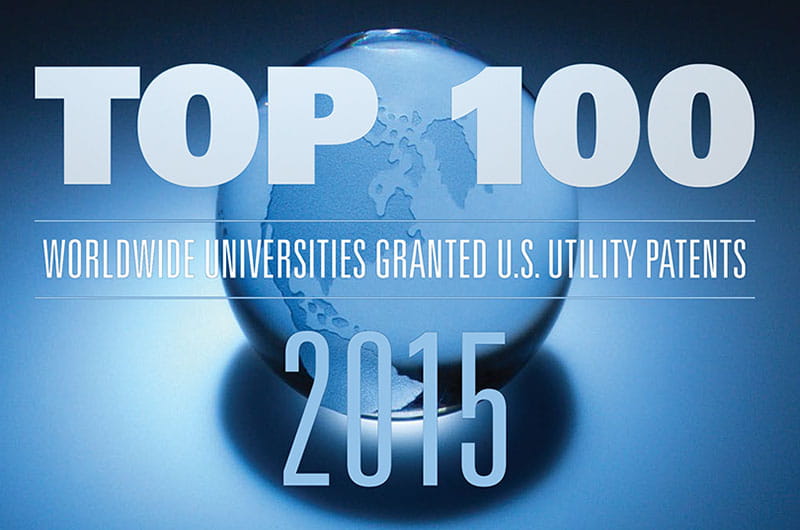Drexel in the Top 50 of Worldwide List for Patents

- Drexel University Recognizes Morgan Lewis Chair Jami McKeon as Business Leader of the Year
- Drexel University's Recent Academic Activity: Sponsored Opportunities and New Partnerships
- How Are Coastal New Jersey Communities Communicating Hazards of Climate Change?
- Drexel to Lead $5 Million Multinational Effort to Produce MXene Materials for Water Desalination and Medical Diagnostics

The National Academy of Inventors and Intellectual Property Owners Association released the Top 100 Worldwide Universities Granted U.S. Patents Rankings, putting Drexel at 49th.
The list ranks Drexel 37th among U.S. institutions. This puts the University ahead of such prestigious institutions as Princeton (No. 54), Yale (No. 71) and Northeastern (No. 80).
Officially, the Top 100 Universities Granted U.S. Utility Patents 2015 list credits Drexel with 42 total patents. Drexel reached this achievement despite having lower research expenditures of any university above us on the ranking. The average reported research expenditures in 2014 for institutions higher up on the list, such as the University of California and the University of Texas systems, is more than $900 million, compared to Drexel’s $111 million.
“Our faculty are very innovative, engaged in technology commercialization and truly want to see their innovations come to market,” said Bob McGrath, PhD, senior associate vice provost and executive director of Drexel’s Office of Technology Commercialization. “A dollar spent on research at Drexel has a far more efficient conversion to innovative, patentable inventions than every school above us on the list. In fact, a dollar spent at Drexel gets you the same patented innovation returns on average as $3.50 at the larger institutions.”
A significant part the University’s research infrastructure is Drexel Ventures, of which the Office of Technology Commercialization is a part.
“Drexel Ventures provides innovation services such as technology transfer, commercialization and startup services for academic innovators wanting to start their own companies,” said Keith Orris, senior vice president of corporate relations and economic development. “We average four to six new startups a year.”
This forward-looking technology has had clear results. In the past two years, a Drexel technology was brought to market, Drexel had a device approved by the FDA and a Drexel company went public for the first time.
Kapil Dandekar, PhD, and his colleagues at the College of Engineering developed a reconfigurable antenna system that adapts the wireless connection to computers and phones in a way that optimizes the connection and makes more reliable than typical “dumb” antenna systems. The technology was used to create a startup company, Adant Inc., founded by Daniele Piazza, PhD '09, Dandekar’s former student, in collaboration with investors. The technology first came to market in 2015 through a partnership with the wireless base station manufacturer Zyxel.
The Drexel-Coulter Translational Research Partnership Program funded the development of a tumor detection system developed by Wan Y. Shih of the School of Biomedical Engineering, Science and Health Systems and Wei-Heng Shih, PhD, of the College of Engineering. The non-invasive system uses sensitive electronic sensors that can detect tumors lying hidden under the skin. UE Life Sciences, a small company founded by Drexel alumnus Mihir Shah '00, has developed the iBreastExam system based on this technology to detect breast cancer and received clearance from the FDA for its use in 2015.
Unique drugs developed by College of Medicine researchers were licensed to Oncore Biopharma Inc., a new company founded to pursue a cure for Hepatitis B. The company, which was led by the development and business team that discovered the Hepatitis C cure known as Sovaldi, merged in 2015 with Tekmira Pharmaceuticals of Canada to create Arbutus Biopharma Inc. The merger resulted in the first of Drexel’s startup companies to go public and the funds raised through that financing have resulted in research results that are expected to bring the drugs into clinical testing within the next nine to 12 months.
“These are not just patents, they are new ideas, new products, new companies,” Orris said. “They help attract companies that want to partner with us through collaborative research and to develop our innovations for the commercial market. It’s this kind of recognition that will bring more interest and investment, bringing innovative corporate partners and researchers to Schuylkill Yards. These patents are Drexel’s future in so many ways.”
Drexel News is produced by
University Marketing and Communications.
